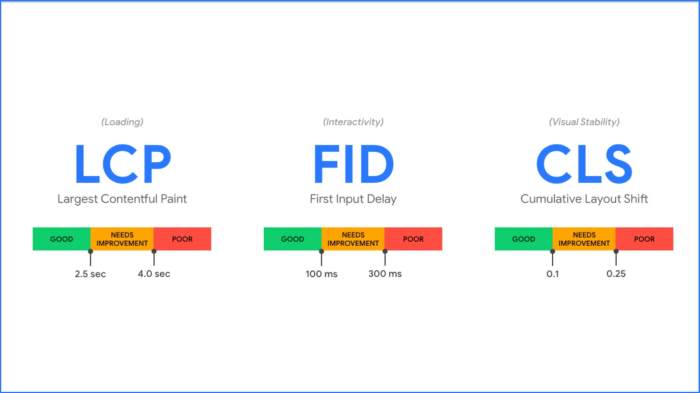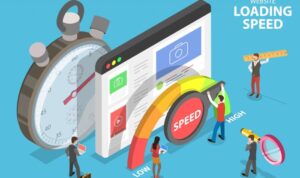Understanding Google’s Core Web Vitals sets the stage for boosting your website’s performance to new heights, uncovering the secrets behind optimal user experiences and success.
Get ready to dive deep into the world of Core Web Vitals and discover how they can revolutionize your online presence.
Introduction to Core Web Vitals

Core Web Vitals are a set of specific factors that Google considers important in measuring the overall user experience of a website. These metrics focus on aspects like loading speed, interactivity, and visual stability, which directly impact how users perceive and interact with a site.
Examples of Core Web Vitals Metrics
- Largest Contentful Paint (LCP): This metric measures the loading performance of a webpage by evaluating how quickly the main content is displayed to users. A good LCP score indicates fast loading times, leading to a better user experience.
- First Input Delay (FID): FID measures the responsiveness of a webpage by evaluating the time it takes for the page to become interactive when a user initiates an action, such as clicking a button. A low FID score indicates a more responsive website.
- Cumulative Layout Shift (CLS): CLS measures the visual stability of a webpage by evaluating the amount of unexpected layout shifts that occur during the loading process. A low CLS score indicates a more visually consistent experience for users.
Importance of Understanding Core Web Vitals
Core Web Vitals play a crucial role for website owners as they directly impact the overall user experience and search engine rankings. By optimizing these metrics, website owners can improve the performance and usability of their sites, leading to increased user satisfaction, engagement, and ultimately, better visibility in search results.
Largest Contentful Paint (LCP): Understanding Google’s Core Web Vitals
Largest Contentful Paint (LCP) is a key metric that measures the loading performance of a webpage by analyzing how long it takes for the largest content element to become visible to users. This element could be an image, a video, or a block of text.
LCP directly impacts user experience as it determines how quickly users can see and interact with the main content on a webpage. A fast LCP contributes to a positive user experience, while a slow LCP can lead to user frustration, higher bounce rates, and lower conversion rates.
Optimizing LCP Performance
To optimize LCP performance on a website, consider the following strategies:
- Optimize images and videos: Compress images and videos to reduce their size without compromising quality. Use modern image formats like WebP and lazy loading to prioritize loading the most important content first.
- Minimize server response times: Improve server response times by using a content delivery network (CDN), optimizing server configurations, and reducing the number of redirects.
- Eliminate render-blocking resources: Identify and eliminate any CSS or JavaScript files that are blocking the rendering of the largest content element. Use asynchronous loading or defer scripts to improve loading speed.
- Prioritize above-the-fold content: Ensure that above-the-fold content, including the largest content element, loads quickly to provide users with a fast initial impression of the webpage.
- Monitor performance regularly: Use tools like Google PageSpeed Insights or Lighthouse to analyze LCP performance and identify areas for improvement. Continuously monitor and optimize LCP to provide users with a seamless browsing experience.
First Input Delay (FID)

First Input Delay (FID) is a crucial metric that measures the time it takes for a webpage to become interactive. It focuses on the delay between a user’s first interaction with a page, such as clicking a button or a link, and the browser’s response to that action. A poor FID score can result in a frustrating user experience, leading to high bounce rates and decreased engagement on your website.
Factors affecting FID scores
- JavaScript Execution: Complex JavaScript operations can block the main thread, causing delays in processing user input.
- Large Resource Loading: Heavy resources like images, videos, or scripts can slow down the page loading speed, impacting FID.
- Third-party Scripts: Integrating excessive third-party scripts can introduce additional delays in page responsiveness.
Strategies to improve FID
- Optimize JavaScript: Minimize and defer unnecessary JavaScript to avoid blocking the main thread.
- Lazy Loading: Implement lazy loading for images and videos to prioritize critical content loading first.
- Reduce Third-party Scripts: Evaluate and limit the number of third-party scripts on your website to enhance performance.
- Prioritize Critical Resources: Load essential resources first to ensure faster interaction response times.
Cumulative Layout Shift (CLS)
Cumulative Layout Shift (CLS) measures the unexpected shifts in the visual layout of a webpage as it loads and interacts with user input. It quantifies how much content moves around on the screen, causing frustration for users trying to interact with the page.
Impact of CLS on User Experience and , Understanding Google’s Core Web Vitals
Cumulative Layout Shift can have a significant impact on user experience, leading to confusion, accidental clicks, and a generally frustrating browsing experience. Users may become annoyed and leave the site if they have trouble navigating due to constant layout changes. From an perspective, CLS can negatively affect a website’s rankings as search engines prioritize user-friendly sites.
- High CLS values can result in lower user engagement and higher bounce rates.
- Google considers CLS as a ranking factor, so sites with poor layout stability may be penalized in search results.
- Improving CLS can lead to better user retention, increased time on site, and ultimately, higher conversion rates.
Best Practices for Minimizing CLS Issues
To minimize Cumulative Layout Shift issues on a website, consider the following best practices:
- Ensure all content elements have predefined sizes to prevent sudden layout changes.
- Load images and ads with reserved space to avoid pushing content down when they appear.
- Avoid dynamically injected content that can unexpectedly shift existing elements.
- Implement CSS animations carefully to prevent layout shifts during transitions.
- Regularly test your website using tools like Google PageSpeed Insights to identify and address CLS problems.









